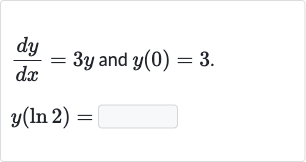AI tutor
Full solution
Q. and .
- Separate variables: First, we need to solve the differential equation . This is a separable differential equation, so we can separate the variables and .
- Integrate both sides: We move to one side and all the terms to the other side to integrate. So we get .
- Find integration constant: Now we integrate both sides. The integral of is , and the integral of is . So we have , where is the integration constant.
- Find particular solution: We need to find the value of using the initial condition . Plugging in the values, we get , which simplifies to .
- Exponentiate both sides: Now we have the particular solution . To find , we exponentiate both sides to get .
- Drop absolute value: Since is positive from the initial condition , we can drop the absolute value to get .
- Simplify exponential term: We simplify to just , so the equation becomes .
- Substitute value: Now we need to find . We substitute with to get .
- Simplify exponential term: We use the property of exponents to simplify to , which is .
- Calculate final result: So . Calculating gives us , and multiplying by gives us .

